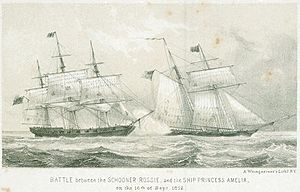Princess Amelia (1799 packet) facts for kids

Rossie capturing Princess Amelia, 1812
|
|
Quick facts for kids History |
|
|---|---|
| Name | Princess Amelia |
| Namesake | Princess Amelia of the United Kingdom |
| Launched | 1799 |
| Fate | Captured September 1812 |
| Name | USS Georgia |
| Namesake | Congressman George Troup of Georgia |
| Acquired | By purchase of a prize |
| Renamed | USS Troup |
| Fate | Sold, 1815 |
| General characteristics | |
| Type | Brig |
| Tons burthen | 179 (bm) |
| Sail plan | Brig |
| Complement | 28 (British service) |
| Armament |
|
The Princess Amelia was a ship built in 1799. She worked as a packet ship for the British Post Office. This meant she carried mail, important messages, and passengers across the seas. She sailed to many places like North America, the West Indies, the Mediterranean, and Brazil.
In 1800, a French privateer captured her. A privateer was like a private ship that was allowed by its government to attack enemy ships during wartime. But the Princess Amelia was soon returned to service. Later, in 1812, at the start of the War of 1812 between the United States and Great Britain, an American privateer named Rossie captured her. The United States Navy then bought her and first called her USS Georgia, but later changed her name to USS Troup. She served as a guard ship in Savannah, Georgia, and was sold in 1815.
Contents
What Was a Packet Ship?
As a packet ship, Princess Amelia made many trips from Falmouth, a port in England. Her journeys included voyages to Jamaica, the Mediterranean Sea, and Brazil. These ships were vital for communication and travel before modern transportation existed.
Captured by a French Privateer
On May 14, 1800, while returning from the Leeward Islands, the Princess Amelia was captured by a French privateer called Decide. The French ship took her to Bordeaux, France. However, the Princess Amelia was later returned to the British Post Office Packet Service. By December 17, 1800, she was back at sea, sailing for Jamaica.
Helping Other Ships
In December 1800, another packet ship, the Grantham Packet, was shipwrecked near Barbados. The people on board were saved. The Princess Amelia helped by taking the passengers and mail that the Grantham Packet was supposed to carry. She left Jamaica on February 8 and arrived back in Falmouth on March 22.
Dealing with Illness at Sea
Sometimes, long voyages could be dangerous due to diseases. The Princess Amelia had to go into quarantine twice in Falmouth because of deaths from fever. For example, in 1805, two crew members died of fever on a trip from Tortola. In 1807, her captain and eight crew members sadly died of yellow fever in Jamaica.
The War of 1812 and Capture
In August 1812, the Princess Amelia left Barbados and sailed towards England. During this journey, she met the American privateer Rossie. This was at the beginning of the War of 1812 between the United States and Great Britain.
A Fierce Battle
The Rossie was a stronger ship, armed with ten 12-pounder guns and one 9-pounder gun. She had a crew of 95. The Princess Amelia was smaller, with only four 6-pounder guns and two 9-pounder guns, and a crew of 27 or 28.
The battle was tough for Princess Amelia. She lost three men, including her captain, Isaac Moorsom, and her sailing master, John Nankivell. Eleven more men were wounded. The Princess Amelia had to surrender. The American ship Rossie had seven men wounded.
After the Capture
The Rossie sent the captured Princess Amelia to Savannah, Georgia, in the United States. Reports from American sources said that the passengers on the Princess Amelia were treated very well by Captain Barney of the Rossie.
USS Troup
Once in Savannah, the United States Navy bought the Princess Amelia. They first named her USS Georgia. However, her name was soon changed to USS Troup. She was named after Congressman George Troup of Georgia, who had suggested that the Navy buy the ship.
The US Navy used USS Troup as a guard ship and a receiving ship in Savannah for the rest of the War of 1812. A Captain Walpole was in command of her. In 1815, after the war ended, the USS Troup was sold.
Sources
- Brannan, J. (1823). Official Letters of the Military and Naval Officers of the United States, During the War with Great Britain in the Years 1812, 13, 14, & 15: With Some Additional Letters and Documents Elucidating the History of that Period: https://books.google.com/books?id=_LMTAAAAYAAJ. Library of American civilization. Way & Gideon. https://books.google.com/books?id=_LMTAAAAYAAJ.
- This article incorporates text from the public domain Dictionary of American Naval Fighting Ships. The entry can be found here.
- Dudley, W.S.; Crawford, M.J.; Hughes, C.F.; Naval Historical Center (U.S.) (1985). The Naval War of 1812: A Documentary History. The Naval War of 1812: A Documentary History. Naval Historical Center, Department of Navy. ISBN 978-0-945-27406-3. https://books.google.com/books?id=JtvZAAAAMAAJ.
- Norway, A.H. (1895). History of the Post-office Packet Service Between the Years 1793-1815. Macmillan and Company. https://books.google.com/books?id=a3Q0AAAAMAAJ.
- Silverstone, P.H. (2006). The Sailing Navy, 1775-1854. The U.S. Navy warship series. Routledge. ISBN 978-0-415-97872-9. https://books.google.com/books?id=fyk6ocYiVvwC.

